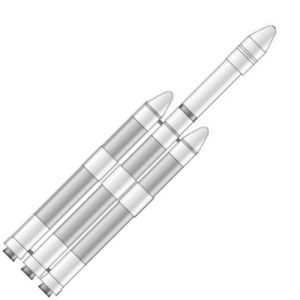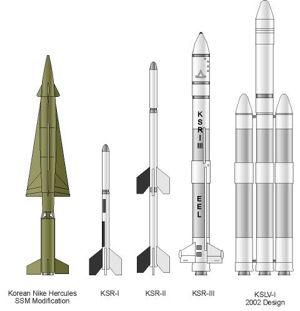
Home - Search - Browse - Alphabetic Index: 0- 1- 2- 3- 4- 5- 6- 7- 8- 9
A- B- C- D- E- F- G- H- I- J- K- L- M- N- O- P- Q- R- S- T- U- V- W- X- Y- Z
KSLV-I 2002
 KSLV-I 2002 KSLV-I as conceived in 2002, with the indigenous South Korean engine shown beside it. Credit: © Mark Wade |
AKA: Korea Space Launch Vehicle-I. Status: In development. Payload: 100 kg (220 lb). Thrust: 244.00 kN (54,853 lbf). Gross mass: 20,000 kg (44,000 lb). Height: 30.00 m (98.00 ft). Diameter: 3.90 m (12.70 ft). Apogee: 300 km (180 mi).
Originally it was planned that the KARI Space Launch Vehicle would be entirely indigenous, building on the systems developed for the KSR-III liquid-propellant sounding rocket launched on November 28, 2002. A drawing of this vehicle showed it to be based on the 12.5-metric ton thrust liquid oxygen/kerosene rocket flown on the KSR-III Two KSR-III stages would flank the core, forming the first stage. The second stage would be the first stage of the core, consisting of a single KSR-III. A solid propellant motor, perhaps based on that flown on the KSR-I and KSR-II, would provide the third stage.
LEO Payload: 100 kg (220 lb) to a 300 km orbit at 38.00 degrees.
Stage Data - KSLV-I 2002
- Stage 0. 2 x KSR-3. Gross Mass: 5,000 kg (11,000 lb). Empty Mass: 700 kg (1,540 lb). Thrust (vac): 122.500 kN (27,539 lbf). Isp: 280 sec. Burn time: 95 sec. Isp(sl): 240 sec. Diameter: 1.00 m (3.20 ft). Span: 1.00 m (3.20 ft). Length: 9.60 m (31.40 ft). Propellants: Lox/Kerosene. No Engines: 1. Engine: KSR-3. Status: Hardware 2002. Comments: All values except thrust estimated.
- Stage 1. 1 x KSR-3. Gross Mass: 5,000 kg (11,000 lb). Empty Mass: 700 kg (1,540 lb). Thrust (vac): 122.500 kN (27,539 lbf). Isp: 280 sec. Burn time: 95 sec. Isp(sl): 240 sec. Diameter: 1.00 m (3.20 ft). Span: 1.00 m (3.20 ft). Length: 9.60 m (31.40 ft). Propellants: Lox/Kerosene. No Engines: 1. Engine: KSR-3. Status: Hardware 2002. Comments: All values except thrust estimated.
- Stage 2. 1 x KSR-1. Gross Mass: 1,000 kg (2,200 lb). Empty Mass: 100 kg (220 lb). Thrust (vac): 86.200 kN (19,379 lbf). Isp: 250 sec. Burn time: 25 sec. Isp(sl): 220 sec. Diameter: 0.42 m (1.37 ft). Span: 0.42 m (1.37 ft). Length: 4.70 m (15.40 ft). Propellants: Solid. No Engines: 1. Status: Hardware 2002. Comments: All values except thrust estimated.
Family: orbital launch vehicle. Country: Korea South. Stages: KSR-3, KSR-1. Agency: KARI.
 | S Korean LVs South Korean indigneous rockets. Credit: © Mark Wade |
 | S Korean LVs South Korean space launch vehicles, including Russian Angara-derived vehicles. Credit: © Mark Wade |
Back to top of page
Home - Search - Browse - Alphabetic Index: 0- 1- 2- 3- 4- 5- 6- 7- 8- 9
A- B- C- D- E- F- G- H- I- J- K- L- M- N- O- P- Q- R- S- T- U- V- W- X- Y- Z
© 1997-2019 Mark Wade - Contact
© / Conditions for Use